Cricket remains India’s most-watched sport — but the last decade has seen a clear, sustained rise in non-cricket disciplines. From archery teams winning world medals to professional kabaddi leagues filling stadiums, and women’s hockey competing at the highest level, India’s sporting profile is diversifying. This shift reflects better grassroots investment, new professional leagues, targeted government policy and growing commercial interest —and it matters for talent development, national pride and the sports economy long term.
Below we map the changes, explain what is driving them, and show why they’re important for athletes, fans and policymakers.
Recent milestones that show the change.
Several concrete results capture the momentum:
- At the World Archery Championships 2025 in Gwangju, India claimed historic compound team golds, signalling the country’s rise in a precision Olympic sport.
- The Pro Kabaddi League (PKL) has become a major commercial success and one of India’s most-watched non-cricket competitions, with viewership in the hundreds of millions across recent seasons — proof that locally rooted sports can scale nationally and commercially.
- India’s women’s hockey team reached the Asia Cup final in 2025 and continues to be a regular performer at continental tournaments — highlighting depth and competitive progress in a sport with strong Olympic potential.
These wins are not isolated: they arrive alongside individual medals in shooting and archery and stronger performances at junior and continental levels — a pattern that shows system-level improvement rather than one-off success.
What’s driving the rise?
Four broad forces explain why non-cricket sports are growing in India.
1. Policy and infrastructure investments
The Indian government’s recent focus on sport — for example, the 2025 National Sports Policy and large Khelo India infrastructure rollouts — has put money and planning behind grassroots development and elite training. The Khelo India programme and newly approved sports infrastructure projects are expanding training centres, improving coaching quality and supporting athletes with allowances and scientific support. These institutional commitments create a wider funnel of talent into multiple sports.
2. Professional leagues and commercialisation
Leagues such as the Pro Kabaddi League have shown a viable model: shorter seasons, city franchises, TV and OTT distribution, celebrity owners, and strong sponsorship deals. That ecosystem brings stable incomes for players, attracts youth to the sport, and makes it easier for brands to enter non-cricket sponsorship. The commercial logic that transformed cricket via the IPL is now producing payoffs in other sports.
3. Sports science, coaching and academies
Universities, private academies and the Sports Authority of India (SAI) are increasingly integrating sports science, physiotherapy and analytics into training. This professionalisation helps convert raw talent into international-level performance, particularly in precision and endurance sports like archery, shooting and athletics.
4. Role models and media visibility
Young athletes winning medals create role models. Media coverage of world-level success and social media storytelling elevate athletes’ profiles, which in turn helps attract sponsorship and community support. As viewership figures show, fans will follow sports that are packaged, promoted and delivered well — even if those sports are not cricket.
Why this matters: impact beyond medals
The rise of non-cricket sports has practical and societal consequences.
Economic opportunity and careers
Professional leagues and improved funding create career paths for athletes, coaches and support staff. The growing sports economy (sponsorship, merchandising, broadcasting rights) helps build sustainable livelihoods beyond short competitive windows.
Broader talent identification
Diversifying the sports ecosystem allows talent from varied geographies and socio-economic backgrounds to find suitable disciplines. Sports like kabaddi, wrestling and archery — which can be practised outside expensive infrastructure — become accessible avenues for rural talent.
International competitiveness
Success across multiple sports improves India’s medal prospects at multi-sport events (Asian Games, Commonwealth Games, Olympics) and raises the country’s global sporting reputation. This matters for national prestige and for inspiring future generations.
Social change and inclusion
Women’s success, in particular, has social spillovers: increased female participation, improved gender norms around sport, and new role models for young girls. The visibility of women’s hockey and women medallists in shooting and archery helps normalise elite sport as a viable pathway for women.
Challenges that remain
The momentum is real but incomplete. Key challenges include:
- Funding gaps and distribution: Many sports depend heavily on government grants; private investment is growing but uneven. Sustainable commercial models must reach beyond a handful of leagues and major cities.
- Grassroots coaching quality: Building coaches and support staff at scale — especially in tier-2 and tier-3 towns — remains essential to convert participation into elite performance.
- Infrastructure maintenance: New stadia and centres need long-term maintenance and programming; short-term project announcements must be matched by operational plans.
- Pathways for post-career support: Athletes need post-competitive career planning (coaching, administration, entrepreneurship) as leagues mature.
What policymakers and stakeholders should do next
- Deepen private-public partnerships: Encourage corporate investment through tax incentives, media rights deals and incubator programmes for emerging sports.
- Scale coach education: National and state bodies should prioritise coaching certification and local coach deployment to strengthen grassroots pipelines.
- Protect athlete welfare: Ensure health cover, pension schemes and educational opportunities so athletes can transition post-retirement.
- Promote gender equity: Targeted funding and media campaigns for women’s sports will preserve and extend recent gains.
Evergreen takeaway
India’s sporting future is no longer a single-sport story. Structural reforms, policy push, commercial experimentation and athlete success are combining to rewrite the playbook. Non-cricket sports are moving from sporadic achievement to systems-driven competitiveness. If stakeholders — government, private investors, federations and communities — sustain this momentum, India can expect broader medal hauls, deeper grassroots participation and a richer sports economy for decades to come.
Also read;How UPI Is Powering India’s Digital Economy and Global Reputation
